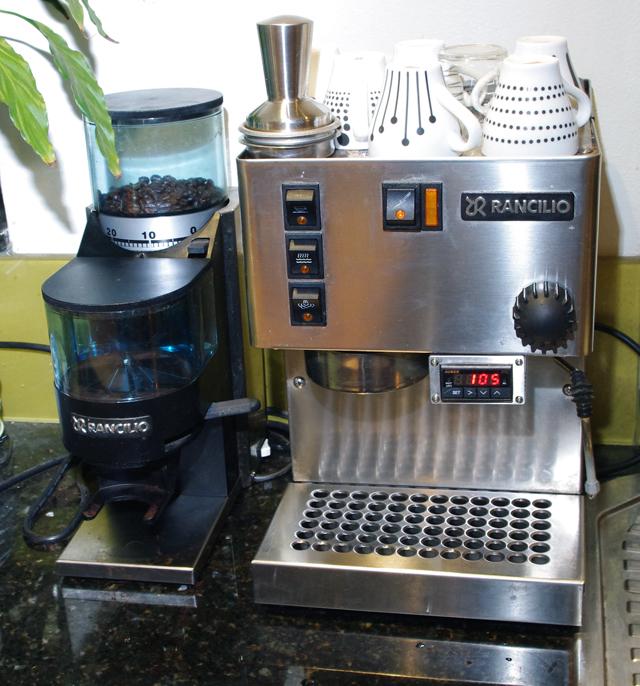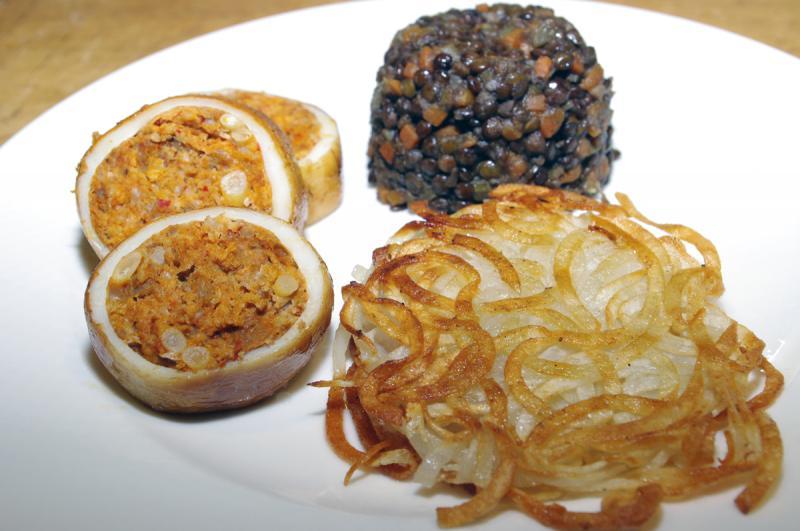-
Posts
2,606 -
Joined
-
Last visited
Content Type
Profiles
Forums
Store
Help Articles
Everything posted by nickrey
-
? (I meah other than the fact that many commercial ghee brands contain ingredients that don't come from butter - or cows - in the first place and so to me are less authentically ghee than what's traditional ?) It is my understanding that ghee is to clarified butter what dark roux is to light roux: the butter is cooked until it is golden brown and then clarified, as opposed to clarified butter, which is cooked such that it is not coloured. I'm interested in any additional differences as well.
-
Espresso. I see re-reading that both of you use the one grinder and one setting for espresso, which makes sense. For a number of reasons I've been switching between beans for espresso and it is a pain recalibrating the machine each time you change beans.
-
-
I've been moving a bit between beans and find that I need to adjust my grind to perfect the 30 sec pour. How do those people who swap between beans for individual cups manage this? Do you record the appropriate setting for each bean and adjust your grinder accordingly?
-
Basically what Janeer said above but without mashing. This recipe for tonno e fagioli is from Marcella Hazan's Italian Cooking. Half a red onion, finely sliced soaked in water for half an hour, change water a few times during this period. Drain and add the contents of one 440g can cannellini beans. Use a good quality smallish can of tuna in olive oil, around 150g. Flake the tuna and add it to the salad. Use additional olive oil and balsamic to dress and season with pepper and salt (be light handed with the salt because the canned tuna will already be salted). Ideal as a brunch dish or as a light salad. And what about vitello e tonnato, which is an Italian dish with veal smothered with a canned tuna sauce? Here's a recipe from the NY Times.
-
Potatoes cooked in duck fat. Perfection.
-
Can't contribute much to your discussion of setting the egg white but I can help you to get the eggs out easier. I use one of these egg openers to produce a "lid" on the wider end of the shell that can be easily removed. Once this is done, the cooked sous vide egg slides easily out of the shell.
-
I have used the SVM with a rice cooker for a number of years now (I'm on my second SVM, having upgraded to a newer model) and am very happy with it. The SVM can control any electrical appliance that has a straight electrically controlled fixed setting thermostat, including some smokers. If the piece of equipment has a digital electronic controller which needs to be set with cooking parameters before cooking, such as the Masterbuilt electronic smoker, you can't use a SVM. What happens in this instance is that the SVM cuts power to the unit when the target temperature is reached. When the power is reconnected as the temperature drops, the unit does not have any memory of what it was doing and cannot function. For this same reason, the SVM cannot be used with more sophisticated electronic programmable rice cookers.
-
Haven't experimented with this but would assume because it has a different flavour profile and because this infuses into the meat it would make a difference. While keeping in mind all the cautions above about the amount of garlic that you use, I found out when I finally used it that some of the early posters on this issue obviously had a different sense of what is an appropriate amount than me. My advice would be to start conservative and work up until you find out what is best for you.
-

"Modernist Cuisine" by Myhrvold, Young & Bilet (Part 3)
nickrey replied to a topic in Cookbooks & References
I know the MC team are reticent to have kitchen manuals circulating by themselves, and for good reason. How about giving us the option of forwarding our old ones to you to swap for the new one? That way you know there are no errant manuals floating around independent of the sets. -

eG Foodblog: SobaAddict70 - Of Hobbits and Hurricanes
nickrey replied to a topic in Food Traditions & Culture
I was vegetarian for quite a number of years and never felt the urge to use processed soy products to mimic meat. Don't get me wrong, I like soy products but am of the opinion that if you feel such a need to have something meat-like in your diet, why not eat the real thing? As SobaAddict is showing us, you can showcase fantastic vegetable combinations without feeling obliged to fill a psychological void left by not having meat in the dish. -

eG Foodblog: SobaAddict70 - Of Hobbits and Hurricanes
nickrey replied to a topic in Food Traditions & Culture
Really enjoying the blog, can't wait to see some more. -
I wonder if it was as much a function of the rebagging/recompression as the cooking.
-

Pho: absolutely infuriating journey
nickrey replied to a topic in Elsewhere in Asia/Pacific: Cooking & Baking
The darkness or cloudiness that you are getting comes from impurities created by how you cook and handle the stock. What follows is a classical way of making clear stock. It works whether you are making pho or European Beef Stock. Some cooks put the bones that they will be using in water, bring to the boil and then drain off all the water and any impurities that come out of this first boiling. You may fear that this will remove too much flavour but it typically only removes things that will cloud the stock later. In Western style stocks, the bones are often roasted to brown them and many of the impurities drop off the bones in the pan during this stage. When you put all your ingredients together, cover with water and bring just to the boil. Skim off any impurities that rise to the surface during this process. Reduce to a simmer (that's the 's' word). This is where you keep it for your five hours, skimming often. When the stock is cooked let it settle. Put a second container next to your stock pot sufficiently large to take the stock. You will be moving your stock to this container using a ladle and a fine strainer. Most importantly, don't pour the stock across as all the impurities will go across. Take a ladle, fill it gently with the stock, and then pour the mixture from the ladle gently through the strainer. As you get toward the bottom of your original pot, you will see that the mixture is getting cloudy. Don't be tempted to put this across to the other pot (you can still use it for sauces). The clear mixture can be used as is for your stock or you could let it cool in an ice bath and then strain it again through a cheesecloth lined strainer. -

Pho: absolutely infuriating journey
nickrey replied to a topic in Elsewhere in Asia/Pacific: Cooking & Baking
It sounds like an error in making your stock. If you boil it overly or do not skim it continually, it will come out as you described. You could always try clarifying it with finings, something like an egg white raft. -
I agree with SylviaLovegren's procedure and would also support others who suggest adding different varieties of cheese to add to the flavour profile. If you wanted to make a sweeter (and probably more Medieval) variant try adding a bit of sugar and some cinnamon to your recipe.
-
Wandered into the local fish shop and saw some lovely calamari. Decided to try stuffed calamari. Stuffed it with minced pork, pine nuts, salt, pepper, paprika, and chili. Cooked it sous vide at 80C for a few hours then browned off in a hot pan. Also decided to try new take on potato cakes. They were going to be quite thick so after slicing them with my Benriner rotary "cook help," I stuffed them into stainless steel food stack rings, vacuum packed them and cooked sous vide at 80C for a few hours. Finished these off by removing from rings and frying in duck fat. Other vegetable is a melange of puy lentils, onion, carrot and celery cooked in chicken stock. Was tasty. Filling of squid was a bit dry. Not sure whether I had enough fat in or it it was the sous vide cooking. Made up leftover mixture into sausages so will try one of those and decide. Will definitely try again, perhaps making rich sauce from tentacles, etc.
-
If you want to look at the original concept, the pressure frying patent (USA patent 3245800 dated 04/12/1966) can be found here. It is not a pressure cooker with oil in it so, as LindaK said, don't even think about trying it.
-
There's a Neapolitan recipe that stuffs roasted, skinned peppers with spaghetti, capers, black olives, and tomato sauce. Sort of an inverse of your original question.
-
Kate, What a fantastic blog! I've been incommunicado in rural Victoria with erratic Internet access but have been following on my iPad where I can. Great to see more of the Asian side of the city and finally understand how you come up with those scrumptious fusion foods. Looking forward to trying out some of your recommendations.
-
I agree that, apart from eggs, the main reason for having high levels of accuracy is if you are playing at the edge of safe cooking temperatures and if you are working with minimum times for achieving outcomes such as pasteurisation. If you cook over 55C and add a safety margin onto the pasteurisation times, a reasonable level of accuracy (+/- 1C) is more than sufficient. Also, if your error is higher than the target temperature (overshoots with no undershoots), you can even get away with larger variations.
-
Perhaps it's a personal operator error with making home-made breadcrumbs but yes I do think they're better.
-
Magic? No. But Panko are surely the best breadcrumbs I've come across for frying.



